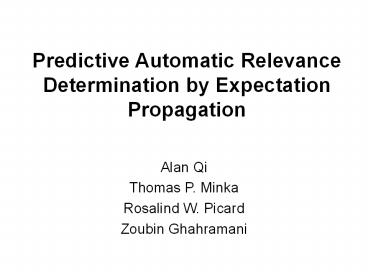Predictive Automatic Relevance Determination by Expectation Propagation - PowerPoint PPT Presentation
Title:
Predictive Automatic Relevance Determination by Expectation Propagation
Description:
Predictive Automatic Relevance Determination by Expectation Propagation. Alan Qi. Thomas P. Minka ... Where is a cumulative distribution function for a ... – PowerPoint PPT presentation
Number of Views:115
Avg rating:3.0/5.0
Title: Predictive Automatic Relevance Determination by Expectation Propagation
1
Predictive Automatic Relevance Determination by
Expectation Propagation
- Alan Qi
- Thomas P. Minka
- Rosalind W. Picard
- Zoubin Ghahramani
2
Motivation
- Task 1 Classify high dimensional datasets with
many irrelevant features e.g., normal v.s.
cancer microarray data. - Task 2 Sparse Bayesian kernel classifiers for
fast test performance
3
Bayesian Classification Model
Prior of the classifier w
Likelihood for the data
Where
is a cumulative distribution function for
a standard Guassian.
4
Evidence and Predictive distribution
The evidence, i.e., the marginal likelihood of
the hyperparameters
The predictive posterior distribution of the
label for a new input
5
Automatic Relevance Determination (ARD)
- Give the feature weights independent Gaussian
priors whose variance, , controls how far
away from zero each weight is allowed to go. - Maximize , the marginal likelihood of
the model with respect to . - Outcome many elements of go to infinity,
which naturally prunes irrelevant features in the
data.
6
Risk of Optimizing
Max-Margin
Max-Evd-1
Bayes Point
Max-Evd-2
- X Class 1 vs O Class 2
7
Two types of overfitting
- Classical Maximum likelihood
- Optimizing the classifier weights w can difrectly
fit noise in the data, resulting a complicated
model. - Type II Maximum likelihood (ARD)
- Optimizing the hyperparameters corresponds
to choose which variables are irrelevant.
Choosing a simple model can also overfit if we
maximize the model marginal likelihood.
8
Overfitting by Type II ML training
- Particularly, if maximizing the marginal
likelihood of the model and the dimension of
(the number of the features) is large, there
exists the risk of overfitting (as shown in some
practical examples).
9
Predictive-ARD
- Choosing the model with the best estimated
predictive performance instead of the most
probable model. - Expectation propagation (EP) estimates the
leave-one-out predictive performance without
performing any expensive cross-validation.
10
Estimate Predictive Performance
- Predictive posterior given a test data point
- EP estimate of predictive leave-one-out error
probability - EP estimate of predictive leave-one-out error
count
11
Expectation Propagation in a Nutshell
- Approximate a probability distribution by
simpler parametric terms - Each approximation term lives in an
exponential family (e.g. Gaussian)
12
EP in a Nutshell
- Three key steps
- Deletion Step approximate the leave-one-out
predictive posterior for the ith point - Minimzing the following KL divergence by moment
matching - Inclusion
- The key observation we can use the approximate
predictive posterior, obtained in deletion step,
for model selection. No extra computation!
13
Sequential Update
- EP approximates true likelihood terms by
Gaussian virtual observations. - Based on Gaussian virtual observations, the
classification model becomes a regression model. - Then, we can achieve efficient sequential updates
without maintaining and updating a full
covariance matrix. (Faul Tipping 02)
14
Comparison of different model selection criteria
for ARD training
- 1st row Test error
- 2nd row Estimated leave-one-out error
probability - 3rd row Estimated leave-one-out error counts
- 4th row Evidence (Model marginal likelihood)
- 5th row Fraction of selected features
15
Gene Expression Classification
- Task Classify gene expression datasets into
different categories, e.g., normal v.s. cancer - Challenge Thousands of genes measured in the
micro-array data. Only a small subset of genes
are probably correlated with the classification
task.
16
Classifying Leukemia Data
- The task distinguish acute myeloid leukemia
(AML) from acute lymphoblastic leukemia (ALL). - The dataset 47 and 25 samples of type ALL and
AML respectively with 7129 features per sample. - The dataset was randomly split 100 times into 36
training and 36 testing samples.
17
Classifying Colon Cancer Data
- The task distinguish normal and cancer samples
- The dataset 22 normal and 40 cancer samples with
2000 features per sample. - The dataset was randomly split 100 times into 50
training and 12 testing samples. - SVM results from Li et al. 2002
18
Bayesian Sparse Kernel Classifiers
- Using feature/kernel expansions defined on
training data points - Predictive-ARD-EP trains a classifier that
depends on a small subset of the training set. - Fast test performance.
19
Test error rates and numbers of relevance or
support vectors on breast cancer dataset.
- 50 partitionings of the data were used. All
these methods use the same Gaussian kernel with
kernel width 5. The trade-off parameter C in
SVM is chosen via 10-fold cross-validation for
each partition.
20
Test error rates on diabetes data
- 100 partitionings of the data were used.
Evidence and Predictive ARD-EPs use the Gaussian
kernel with kernel width 5.
21
Summary
- ARD is an excellent Bayesian feature selection
and sparse learning method. - However, maximizing marginal likelihood can lead
to overfitting if there are a lot of features. - We propose Predictive ARD based on EP
- In practice it works very well.
- Related work Opper Winther 2000.






























